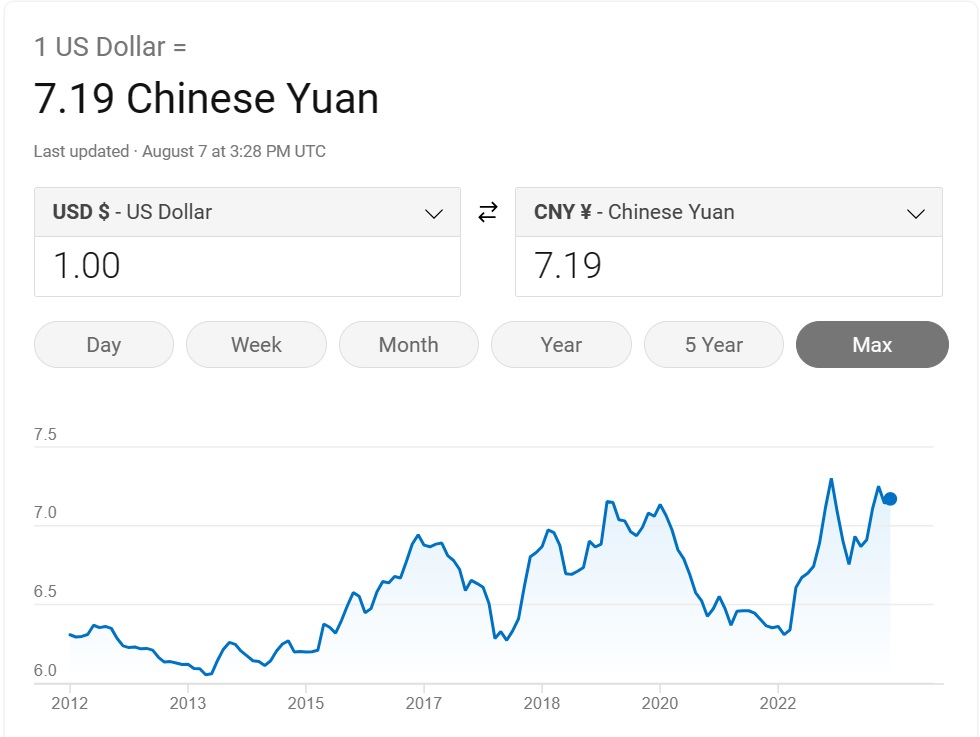Yuan loses core support as firms leave China
Source: Yuan loses core support as firms leave China (yahoo.com)
SHANGHAI/SYDNEY (Reuters) – Since China opened to foreign investment in 1978 under Deng Xiaoping, global firms have ploughed in hundreds of billions of dollars to buy and build factories for market access and cheap labour, bolstering the Chinese currency.
A gentle downtrend in foreign direct investment gave way to a steep drop last quarter and inflows to China slammed to their lowest since records began 25 years ago, raising the prospect that the long-term trend is turning.
Corporate leaders and their advisers say a shift is under way and the political concerns behind investment decisions are long term, which leaves the yuan facing pressure from what was long one of its staunchest supports.
“FDI has historically not been a huge swing factor in the exchange rate’s value, because you typically had surpluses of $50 to $100 billion a year,” said Logan Wright, director of China Markets Research at analytics firm Rhodium Group.
“But when that swings to a deficit, which is where it is right now … that’s a pretty big adjustment.”
Foreign direct investment (FDI) inflow slowed to less than $4.9 billion for the second quarter, while Chinese companies’ investments abroad sent net direct investment to a record deficit of $34.1 billion, figures published last week by China’s State Administration of Foreign Exchange (SAFE) showed.
Investors and analysts say the decline is the result of firms’ nervousness over the direction of competitive and political friction between China and the West which has already led to trade and investment restrictions and a diplomatic chill.
Sources have told Reuters the Biden administration is likely to adopt new outbound investment restrictions on China in the coming weeks. Japan, the U.S. and Europe have already restricted the sale of high-tech chipmaking tools to Chinese companies while China has hit back by throttling exports of raw materials.
Diplomatic tensions aside, business confidence had already been eroded by three years of Beijing’s strict “zero-COVID” policy of quarantines and lockdowns that disrupted manufacturing and supply chains.
China’s regulatory crackdowns on some industries and raids on U.S. consulting firms have also been unnerving, leading businesses to fret over when and where the next hit was coming.
“I don’t have one client wanting to invest in China. Not a single client,” said John Ramig, shareholder at law firm Buchalter, who specialises in international business deals and structuring of manufacturing.
“Everyone is looking to either sell their Chinese operation, or if they’re sourcing products in China, they’re looking for an alternative place to do that,” he said. “That’s dramatically different from what it was even five years ago.”
Oxford Economics’ analysts say greenfield flows into new production capacities, probably best capture the forward-looking sentiment and have been sliding for years to total just $18 billion in 2022 from running around $100 billion a year in 2010-2011.
BIG DECISIONS
The slide in China FDI has been eye-catching because it has for so long been taken for granted as a fact of global trade and its unravelling portends deeper shifts.
Unlike more fickle portfolio flows from investors, companies’ spending, while cyclical, tends to be stickier and steadier as firms establish and expand production — meaning economic consequences are likely as it unravels.
Pressure on the exchange rate is already being felt.
Dollar purchases via Chinese banks for outbound direct investment has consistently exceeded yuan purchases for foreign inbound investment this year, resulting in six consecutive months of outflows, according to latest SAFE data.
That trend was also captured by Ministry of Commerce data, which showed that paid-in FDI fell 5.6% during the first five months of the year, the biggest decline in three years.
The yuan is down about 4% on the dollar this year, even as the U.S. currency has fallen elsewhere, and has only found support as the central bank has guided its trading range off lows and state banks have been buying in the spot market.
To be sure, investment flows often fluctuate and many firms aren’t leaving China completely or aren’t leaving at all.
Daniel Seeff, whose sockmaking business Foot Cardigan was hit by tariffs and COVID logistical snags looked into shifting production from Haining in the Yangtze River delta to Peru, but wasn’t able to match the quality and price of his China factory.
“For now, I don’t think that China has lost this edge for us,” he said. And Chi Lo, senior investment strategist at BNP Paribas Asset Management in Hong Kong, said such flows are only one part of the yuan’s direction and that it can stay strong.
Still, the data shows enough firms are taking decisions to either quit or avoid adding to capacity in China that will set the tone for capital flows for years to come.
“The political atmosphere is incentivising western companies away from China … because the benefits of being in China are not outweighing the risks,” said Lee Smith, global trade attorney at Baker Donelson.
“A lot of our clients are worried about their exposure to China as a sole country of supply.”
(This story has been corrected to fix John Ramig’s title to shareholder in paragraph 11)
(Reporting by Samuel Shen in Shanghai and Tom Westbrook in Singapore; Additional reporting by Winni Zhou in Shanghai; Editing by Jacqueline Wong)

******************************************
Comments and prediction:
This is a great article to analyze the Yuan (RMB) price.
Currently, China is experiencing a great depression (although not been reported in news), with record high of unemployment rate and facing debt crisis (debt default).
In the next few years, we can see, China’s economy would keep decline and RMB would keep devaluating.
Another big reason that RMB will decline is some countries having more RMB to sell on the market: (1) Russia is selling off RMB (buying US$), because it had big RMB reserve by selling energies to China & India (only accepted RMB); (2) Argentina & Brazil are also selling RMB on the market, because they accepted RMB by selling their soybeans/corns to China. Most of these selling activities are not price-elastic, but instead, a necessary need.
We would estimate RMB reached as low as 8 within 2024, with average may be around 7.5 in 2024. (Today’s exchange rate is 7.19)
If China invades into Taiwan, RMB can be easily break into 9.
Time to short RMB now.
